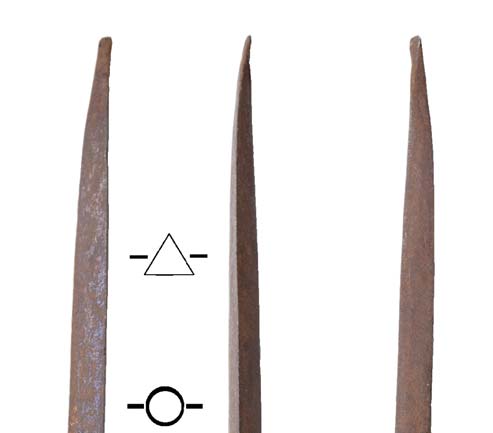TWO PIKE-HEADS FROM THE COLLECTION OF NIZHNY NOVGOROD STATE HISTORICAL AND ARCHITECTURAL MUSEUM-RESERVE
DOI:
https://doi.org/10.24852/2587-6112.2020.6.387.392Keywords:
Russian state, 16th–17th centuries, warfare, armament, tips of the pikesAbstract
The paper introduces into scientifi c discourse two pike-heads from the collection of Nizhny Novgorod State Historical and Architectural Museum-Reserve (Nizhny Novgorod, Russia). Both of them are fi tted on shaft of later historical periods. These items were deposited in the museum collection by the son of a renowned photographer and artist A. O. Karelin (1837–1906); the source of their acquirement by the former owner is unknown. Tips of the pikes are made of iron and feature sockets and a blade with a triangular cross-section of an awl shape and an "apple" on the neck of the blade. The socket of one of the tips has two "veins" (backlines) – metal strips with holes for fi xing nails. For dating of the pike-heads, their design features considered, and close counterparts were found. Their most probable dating and attribution are proposed as Russia, late 16th – fi rst half of 17th centuries, light cavalry pike or the weapons of New order regiments (pikemen, soldiers). The presence of counterparts in Kazakh materials of the 17th –fi rst half of 19th centuries allows the author also to assume later "Oriental" origins of the spearheads.
References
Bagrin, E. A. 2013. Voennoe delo russkikh na vostochnom pogranich’e Rossii v XVII v.: Taktika i vooruzhenie sluzhilykh lyudei v Pribaikal’e, Zabaikal’e i Priamur’e (Russian Military Affairs on the Eastern Border of Russia in the 17th Century: Tactics and Weapons of Servicemen in the Baikal Region, Transbaikalia and Amur Region). Saint Petersburg: “Nestor-Istoriia” Publ. (in Russian).
Bobrov, L. A. 2013. In Voina i oruzhiye: Novyie issledovaniia i materialy. Trudy Tretyey Mezhdunarodnoy nachno-prakticheskoy konferentsii 15–17 maya 2013 goda. Chast’ I (War and Weapons: New Studies and Materials. Proceedings of the Third International Scientifi c-Practical Conference, May 15-17, 2013. Part I). Saint Petersburg: Military-Historical Museum of Artillery, Engineer and Signal Corps, 231–258 (in Russian).
Bobrov, L. A. 2013. In Khudyakov, Yu. S., Skobolev, S. G. (eds.). Voennoe delo srednevekovykh narodov Yuzhnoi Sibiri i Tsentral’noi Azii: sbornik nauchnyh trudov (Military Affairs of the Medieval Peoples of Southern Siberia and Central Asia: Collection of Scientifi c Papers). Novosibirsk: Siberian Branch of the Russian Academy of Sciences, Institute for Archaeology and Ethnography, 96–105 (in Russian).
Bobrov, L. A., Filippovich Yu. A. 2015. In Vestnik Novosibirskogo Gosudarstvennogo universiteta. Istoriia, fi lologiya (Bulletin of the Novosibirsk State University: History, Philology) 14 (3), 93–99 (in Russian).
Bobrov, L. A., Khudyakov Yu. S. 2010. In Vestnik Novosibirskogo Gosudarstvennogo universiteta. Istoriia, fi lologiya (Bulletin of the Novosibirsk State University: History, Philology) 9 (3), 174–181 (in Russian).
Bogoyavlenskiy, S. K. 1938. In Grekov, B. D. (ed.). Istoricheskie zapiski (Historical Notes) 4. Moscow: USSR Academy of Sciences, 258–283. (in Russian).
Gorelik, M. V. 2011. In Mirgaleev, I. M. (ed.). Voennoe delo Zolotoi Ordy. Problemy i perspektivy izucheniia (Military Affairs of the Golden Horde. Study Issues and Prospects). Kazan: Institute of History named after Sh. Mardzhani, Tatarstan Academy of Sciences Publ., 47–58 (in Russian).
Gorodtsov, V. A. 1913. Opisanie kholodnogo oruzhiya Istoricheskogo muzeya (Description of Melee Weapons of the Historical Museum). Trudy Istoricheskogo muzeya (Proceedings of the Historical Museum). Moscow: Synodal Printing House Publ. (in Russian).
Dvurechensky, O. V. 2015. Kholodnoe oruzhie Moskovskogo gosudarstva XV–XVII vekov (Melee Weapons of the Moscow State of the 15th – 17th cc.). Tula, "Kulikovo Pole” State Museum-Reserve Publ. (in Russian).
Kirpichnikov, A. N. 1966. Drevnerusskoe oruzhie (Early Russian Weapons) 2. Kop’ia, sulitsy, boevye topory, bulavy, kisteni IX–XIII vv. (Spears, Lances, War Axes, Maces, Flails of 9th–13th Centuries). Series: Svod Arkheologicheskikh Istochnikov (Corpus of Archaeological Sources) E1-36. Moscow; Leningrad: “Nauka” Publ. (in Russian).
Komarov, O. B. 2016. In Istoriya voyennogo dela: issledovaniya i istochniki. (The History of Warfare: Studies and Sources) 7, 392–460 Available at: http://www.milhist.info/2016/02/03/komarov_1 (Accessed: 26.04.2019). (in Russian).
Nesin, M. A. 2019. In Novogardia. 1, 348–384. (in Russian).
Penskoi, V. V. 2008. Ot luka k mushketu. Voorushonnye sily Rossiyskogo gosudarstva vo 2-y polovine XV–XVII vv.: problem razvitiya (From the bow to the musket. The armed forces of the Russian state in the 2nd half of the XV–XVII centuries: problems of development). Belgorod: Publishing house of Belgorod state University. (in Russian)
Ustav ratnyh, pushechnyh I drugih del, kasayushihst’a do voinskih nauk. Chast’ I (Code on of Military, Cannon and Other Matters Relating to Military Science) II. Saint-Petersburg. (in Russian).
Ucheniye i hitrost’ ratnogo stroyeniya pehotnyh l’udey. 1647 god (Doctrine and Peculiarities of the Military Formation of Infantry Men. 1647). Saint-Petersburg: “Berezhlivost’” Pul. (in Russian).
Chubinskiy, A. N. 2016. In Vojna i oruzhiye: novyje issledovaniya i materialy. Materialy Sed’moy Mezhdunarodnoy nachno-prakticheskoy konferentsii 18–20 maya 2016 goda. Chast’ V (War and Weapons: New Studies and Materials. Proceedings of the Seventh International Scientifi c-Practical Conference, May 18-20, 2016. Part V). Saint Petersburg: Military-Historical Museum of Artillery, Engineer and Signal Corps, 310–340 (in Russian).
Shindler, O. V. 2019. In Novogardia. 1, 323–347. (in Russian).

Downloads
Published
How to Cite
Issue
Section
License
Copyright (c) 2020 B. A. Ilyushin

This work is licensed under a Creative Commons Attribution-NonCommercial 4.0 International License.







